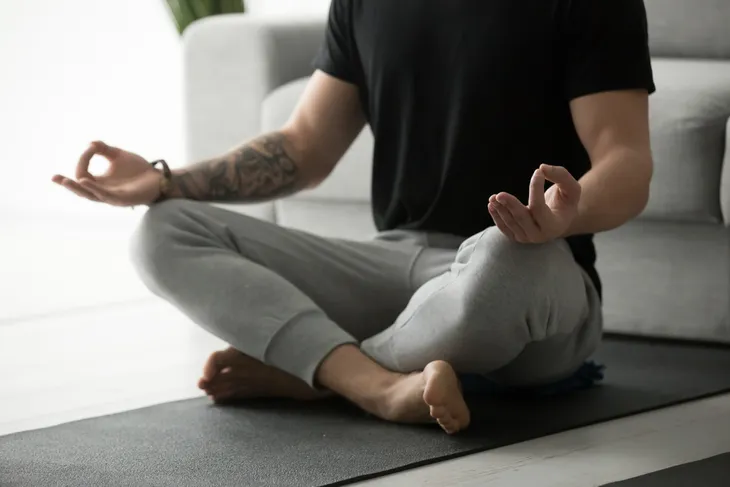Meditation by definition is simply creating awareness. Yogi experts agree that any focused activity free from distraction classifies as meditation. However, too often we find meditation a daunting, complicated, spiritual routine and we’re discouraged before we even begin. Luckily, meditation doesn’t have to be so hard!
According to Zoran Josipovic, a Research Scientist at New York University, who performed MRI scans on the brains of meditating monks, there are many brain-boosting benefits to meditating, including the development of focus, which leads to a more tranquil, happier existence.
If you’re not already convinced, here are six tips to get you started with a meditation practice…
Sit Comfortably
Traditional Buddhist meditation encourages you to meditate in a full lotus pose, cross-legged with each foot resting on the opposite thigh. However, the easiest way to distract your mind with screaming muscles is to sit in a position that causes pain. Most yoga instructors will simply ask you to cross your legs or sit as comfortably as you can without pain.
This means you should prioritize your comfort and sit in a way that is natural and most comfortable for you. To start, the true goal is to focus your awareness on your mind rather than your body. It doesn’t matter how you look or how you get there, as long as you do it safely. You can always work towards the recommended postures in time.
Focus On Your Breathing
If someone asks you not to think, it’s difficult to shut off your mind. All of the little thoughts and stresses of the day easily slip into your mind—and suddenly you’re bombarded with a list of every little thing you have to do after you’re finished meditating. Instead of attempting to shut your mind off completely, focus on your breathing.
Dr. Adam Burke, a Research Psychologist and Assistant Professor who studies brain wave patterns during meditation at San Francisco State University, in California, “Meditation is the study of attention…to breath works…to breathing patterns.” As you focus on your breathing, count to 4 slowly on your inhale, and then count to 6 slowly on your exhale as you count the total breaths you take. This way, your thoughts stay focused on breathing and away from the chaos of everyday consciousness.
Meditate to Music
Researchers from the University of London’s Institute of Education found that when it comes to meditation, or intellectual development of any kind, music can take you there. Listening to quiet, instrumental music as you meditate will help those new to the practice focus their thoughts on something simple as they concentrate on breathing. Try to synchronize your breath with the beat of the music.
This rhythmic pattern can help guide your breath and your mind all the way through a song. If you can get through just one song like this, you’ve given your brain well-deserved respite for at least a few minutes. It may not be a perfect 1-hour session, but breathing along to music can help you develop the skills needed for longer meditation.
Start with Small Intervals
Sitting still for more than a few minutes is daunting for many people. The harder we try to set aside a certain block of time to meditate—the harder it actually is to follow through. It’s common to get swept up in your day and lose the hour you had reserved as your quiet time. But meditation doesn’t have to be a big time commitment.
In fact, Transcendental Meditation Canada, founded by Maharishi Mahesh Yogi, the widely regarded authority on meditation, recommends a mere 20-minutes of practice each day. Develop your meditation practice gradually—as your morning coffee is brewing, as you brush your teeth, or for the length of a song. Even a few short minutes in your day can help cleanse your mind and help you flex your focus muscles.
The True Goal of Meditation
In the twenty-first century, information is available to us wherever we go, and our energy and attention is demanded and divided like never before. Today, our thoughts come and go at record-breaking rates and shutting that down completely can be unrealistic. We all meditate for different reasons—some spiritual, some for pure relaxation, others for both.
According to Austin-based Psychologist Dr. Mike Brooks, the Director of the Austin Psychology and Assessment Center, in Texas, the goal of meditation is often misunderstood. Rather than completely letting go of our thoughts to achieve a state of enlightenment, mediation should be considered a powerful set of techniques for calming and quieting the mind using a mode of consciousness where the practitioner is focused on one thing—sitting and breathing rather than active thinking.
Don’t Get Frustrated
As you learn to mediate remember to be gentle with yourself. After all, you and your mind deserve a break from the thought-filled chaos of the world, and becoming frustrated with yourself will only do more damage than good as you learn to slow down. Trust that meditation will get easier, and give yourself permission to make progress in a practice that will lead to psychological benefits that persist throughout your entire day.
Take it from a Harvard University study that monitored a group of participants taking part in an 8-week mindfulness meditation program. The neuroscientists conducted MRI scans on participants to document how meditation caused massive and positive changes in brain structure. Findings revealed that just 27-minutes of mediation each day stimulated a major increase in gray matter density in the hippocampus—promoting deeper introspection, compassion, and self-awareness that lasted the entire day after meditating.









